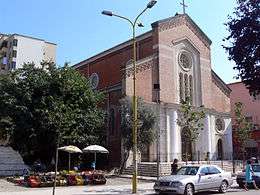Christianity in Albania
.jpg)
Christianity in Albania was established throughout the country in 325 AD. From 1100 AD, the Byzantine Empire carried out Church missions in the area. In relation to the increasing influence of Venice, the Franciscans started to settle down in the area in the 13th century. From the 15th century to the 19th century, under the rule of the Ottoman Empire, Christianity was replaced by Islam as the majority religion in Albania. A Pew Research Center demographic study from 2010 put the percentage of Muslims in Albania at 82.1%.[1] However, the Albanian government gives the percentages of religious affiliations with only 38% Muslim, 16% Eastern Orthodox, 17% Catholic and 25% atheist or nonreligious.[2] In the 2011 census the declared religious affiliation of the population was: 56.7% Muslims, 13.79% undeclared, 10.03% Catholics, 6.75% Orthodox believers, 5.49% other, 2.5% Atheists, 2.09% Bektashis and 0.14% other Christians.[3]
A 2015 study estimated some 13,000 believers in Christ from a Muslim background, though it is not clear to which Christian churches these people had converted.[4]
Eastern Orthodoxy
According to the numbers given by the government in 2010 it was stated that Eastern Orthodoxy was practiced by about 20% of Albanians within Albania.[2] However, in the 2011 census the percentage of Orthodox believers was 6.75%.[3] Eastern Orthodoxy is also practiced by many ethnic Albanians in the Balkans and Albanian communities living in western Europe, the United States and Australia. Albania is historically linked with both Roman Catholicism and Eastern Orthodoxy as well as Islam. Albanians were among the first peoples of the region to receive missionaries and convert to Christianity. With the split of the Church in 1054, Orthodoxy become the religion for the Albanians inhabiting the areas under the Byzantine rule.
The first Orthodox liturgy in the Albanian language was held not in Albania, but in Massachusetts. Subsequently, when the Orthodox Church was allowed no official existence in communist Albania, Albanian Orthodoxy survived in exile in Boston (1960–1989).
Roman Catholicism

The Roman Catholic Church in Albania is part of the worldwide Catholic Church, under the spiritual leadership of the Pope in Rome. According to the numbers given by the government in 2010 it was stated that around 17% of the religious population is Catholic,[2] however in the 2011 census the percentage of Catholics was 10.03%.[3] There are five dioceses in the country, including two archdioceses plus an Apostolic Administration covering southern Albania.
Protestantism
Protestants in Albania, stand at about 8,000,[5] whereas 189 different Protestant associations including the Albanian Evangelical Alliance (VUSH) exist in Albania.[6]
Gallery
-

One of Tirana's Catholic churches.
See also
- Religion in Albania
- Orthodoxy in Albania
- Roman Catholicism in Albania
- Protestantism in Albania
- Islam in Albania
Further reading
Tönnes, Bernhard. "Albania." In The Encyclopedia of Christianity, edited by Erwin Fahlbusch and Geoffrey William Bromiley, 35-36. Vol. 1. Grand Rapids: Wm. B. Eerdmans, 1999. ISBN 0802824137
References
- ↑ Miller, Tracy, ed. (October 2009). "Mapping the Global Muslim Population: A Report on the Size and Distribution of the World's Muslim Population" (PDF). Pew Research Center. Archived from the original (PDF) on 8 November 2009. Retrieved 8 October 2009.
- 1 2 3 Albanian Government. "L'Albania oggi" (in Italian). Ministry of Foreign Affairs of Albania. Archived from the original on 10 May 2008. Retrieved 30 August 2010.
- 1 2 3 Albanian census 2011
- ↑ Miller, Duane; Johnstone, Patrick (2015). "Believers in Christ from a Muslim Background: A Global Census". IJRR. 11: 15. Retrieved 6 December 2015.
- ↑ "First Protestant Church Dedicated". Christianity Today Library.
- ↑ "International Religious Freedom Report 2007: Albania". US Dept. of State/Bureau of Democracy, Human Rights, and Labor. www.state.gov. 15 September 2006. Retrieved 2010-05-13.
- http://religiousfreedom.lib.virginia.edu/nationprofiles/Albania/rbodies.html
- https://web.archive.org/web/20080510072227/http://www.consolatoalbanesemilano.org/lalbania_oggi.html